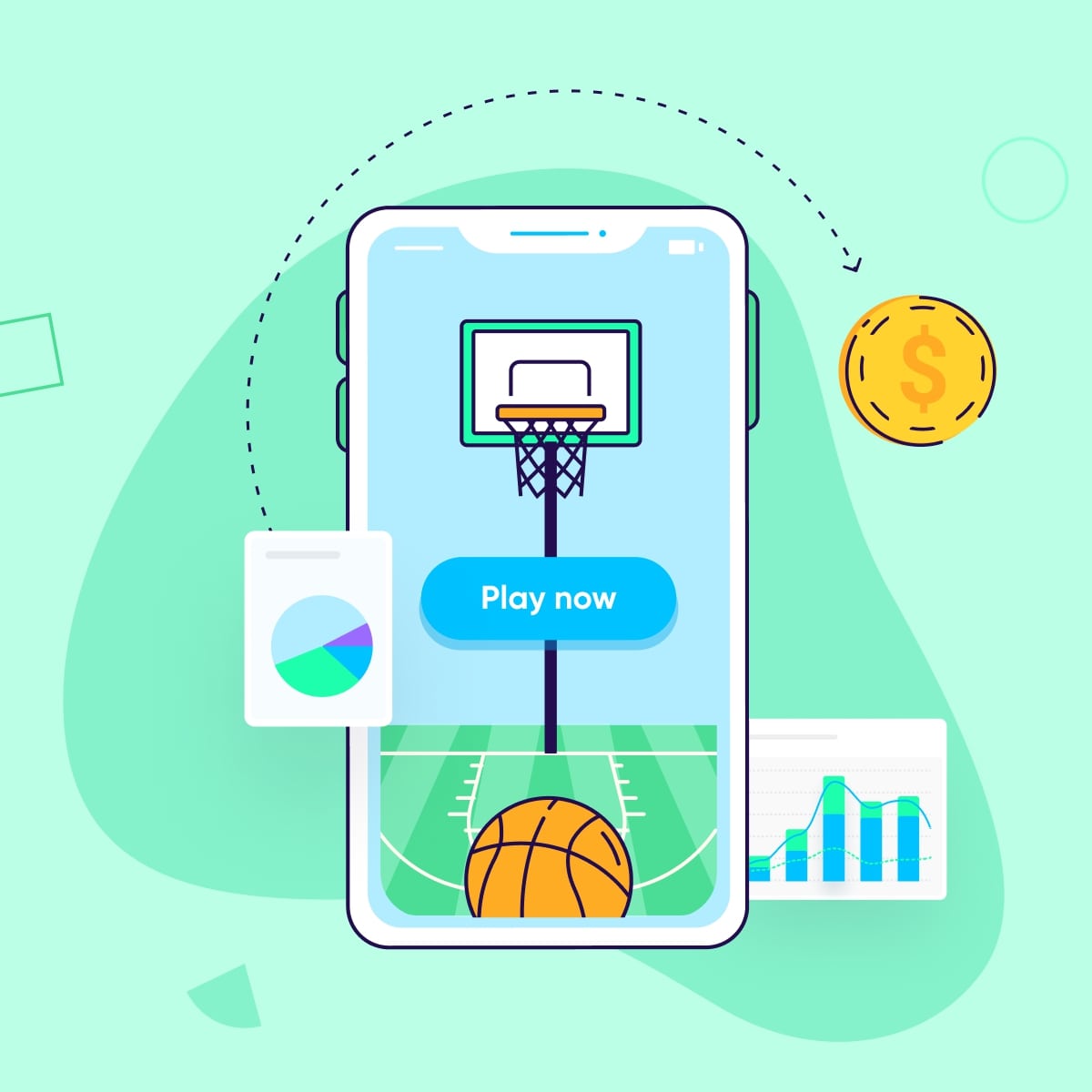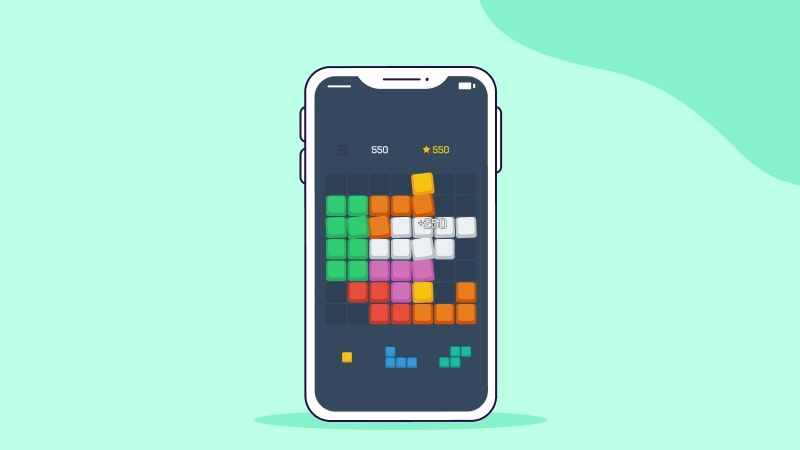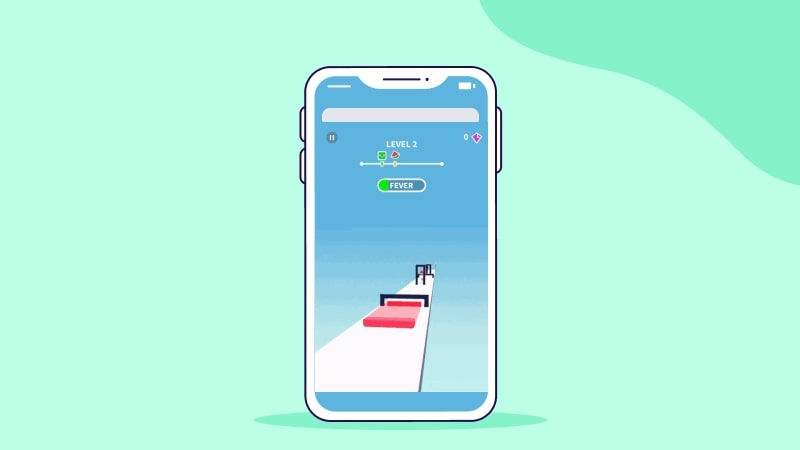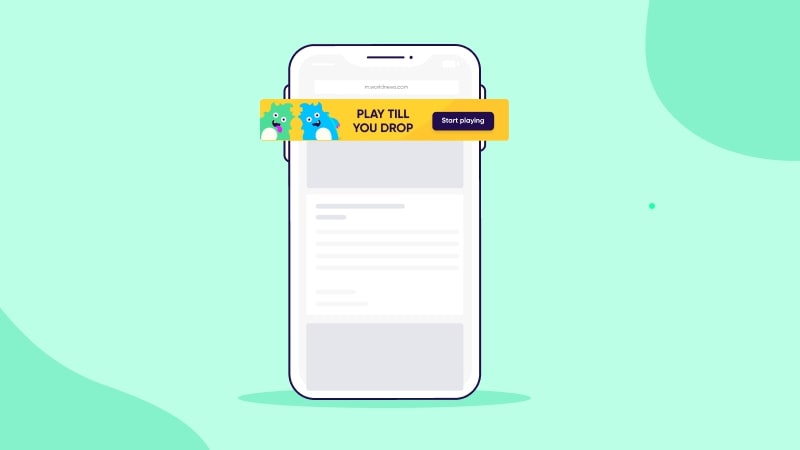What are hyper-casual games, and why are they so popular?
Hyper-casual games are simple, minimalist, yet highly engaging games that are instantly playable and easy to replay, appealing to a broad audience with their quick, enjoyable gameplay.
Try searching for

Hyper-casual games have been booming in recent years: in 2021, they made up 50% of total game downloads, and over a third of the top 100 game downloads globally. And while numbers dipped slightly in 2022, hyper-casual was still the top gaming genre.
But what is it about hyper-casual games that enables such impressive growth? What’s the magic ingredient that helps these games scale?
Let’s just say that phrases like keep it simple stupid and less is more carry plenty of weight here.
In this blog we’ll discuss these key characteristics and various game mechanics, as well as global trends, monetization methods, marketing challenges, and best practices. In short, everything you need to know about hyper-casual games.
Are you ready? Set? Let’s go!
Hyper-casual games are simple in mechanics, design, and concept.
There are a number of key ingredients that make up their secret sauce for success – let’s take a look at the recipe.
Hyper-casual games require little or no tutorial, meaning they’re instantly playable. The user is immediately immersed in the game and can follow the flow of the game in seconds.
The user interface of a hyper-casual game is simple and minimalist. The mechanics are also basic and there aren’t a lot of bells and whistles — no fancy controllers, elements, or complicated menus to get to grips with.
Minimalist design means a user has to invest very little effort to get going. Hyper-casual games can be played while you’re on the train to work or even while watching TV, and are designed to help the user switch off.
Hyper-casual games are not only instantly playable, but infinitely replayable. The short and simple game mechanics mean you want to play them over and over again.

The flip side of the simplicity is that hyper-casual games do tend to have a shorter shelf life than other genres. Don’t despair, because their simplicity also means users can move on to the next game with ease. As a game developer, if you notice that engagement is dropping then you can cross-promote and direct users towards your new game.
Due to their simple design and mechanics, hyper-casual games are easy to develop and launch. Unlike other genres where a new game can take months to develop, hyper-casual games can be created and launched in a matter of days. This is because hyper-casual games are based on a mechanic and not a plot, making the conceptualization and prototyping stages much simpler and shorter.
Due to their simple gameplay, hyper-casual games rely heavily or even exclusively on in-app advertising (IAA) as a revenue stream. We’ll discuss more on this later.
The first known hyper-casual game was Flappy Bird, developed by Dong Nguyen and released in 2013. The game didn’t receive much attention at first, and it wasn’t until the following year that it exploded and started to experience massive scale. At its peak, Flappy Bird was making $50,000 a day from in-app ads.
This success made other app developers sit up and take notice. With relatively low barriers to entry (thanks to the simple game design), it didn’t take long for others to follow suit.
Yet, it wasn’t until 2017 that the term “Hyper-casual” was coined in an article by Johannes Heinze called “The Ascendance of Hyper-casual”, which defined the main features of hyper-casual games as we know them today.
The hyper-casual genre has seen massive growth in recent years, easily commanding 10 of the top 15 spots in the download charts.
Remember March 2020? The world went into lockdown as the Covid-19 pandemic took hold, and we were all stuck at home in need of entertainment and distraction.
For many of us, mobile games were the answer, and the impact on the market was huge. The total number of installs of hyper-casual games surged 90% on the previous year, with many users getting involved for the first time.
Gaming app marketers jumped on this opportunity and put a strong focus on UA campaigns, with non-organic installs leaping 250%. The only way was up, and the market continued to see impressive growth right through 2021.
While hybrid games remain hugely popular, a couple of recent developments have introduced new challenges for marketers.
Apple’s AppTrackingTransparency (ATT) framework came into effect in April 2021, following the launch of iOS 14. The big change was that app owners were required to ask users to opt in to sharing their unique identifier (IDFA).
As a result, user-level data – something marketers had relied on heavily, particularly in the gaming apps world – was suddenly very limited, posing serious challenges in delivering accurate and targeted advertising. Could hyper-casual games still be profitable?
The answer, of course, was yes: hyper-casual games have proved resilient in the wake of iOS14, thanks to their mass appeal, high install rates, revenue from IAA, and short shelf life. And there are solutions to the challenges around visibility, measurement, and targeted advertising, such as aggregated data and predictive analytics.
In 2022, Google updated its ads policy in a bid to improve user experience — potentially putting a brake on the booming hyper-casual market.
Crucially, the changes put limitations on the types of ads that can be shown in games: for example, full-screen ads when the user wouldn’t expect them, and full-screen ads that can’t be closed after 15 seconds, are no longer allowed.
Among other updates, Google is cracking down on ‘copycat’ apps that could mislead customers, tightening requirements on advertising to children, and requiring companies to make it simpler to cancel or modify subscriptions.
While developers and advertisers need to be aware of the policy, these changes shouldn’t come as a great surprise. If you’re a responsible company and follow best UX practices (and why wouldn’t you, if you want to attract and retain users?), you’ll already be serving up higher-quality ads than those mentioned above.
There are a number of different types of hyper-casual games, and naturally each one has its own mechanics. Let’s take a look at how they work.

In the simplest games, the player performs an action or a sequence of actions to solve a puzzle, for example by aiming or swiping. In hyper-casual games, the puzzles are easy and the player should be able to solve them in a minute or less.

Agility games, such as Pac-Man or Tiles Hop are all about hand-eye coordination. The player may have to dodge obstacles and collect coins or prizes. The difficulty and agility level increase with each level.

Timing games, such as Fun Race 3D, require the player to race themselves and reach the goal within the allotted time. Similar to agility games, the player needs to use precision to reach the target. They may also need to collect bonuses or avoid obstacles along the way.

Swerve mechanics have a player on a track where they have to move or avoid obstacles or oncoming hazards. The gameplay is fast paced, keeping the user highly engaged and entertained. Swerve games include Aqua Park and Flappy Birds.

Stacking mechanics have objects that fall from the top of the screen and require the player to slot them into the right place. The classic example is Tetris, but other stacking games include Full Cat.
The popularity of hyper-casual games presents plenty of opportunities for marketers (see further down for the key monetization models). But there are a few challenges to be aware of too.
If you’re an app marketer, you’ll find a lot to love about hyper-casual gaming apps. For example:
Are there any downsides to hyper-casual games from a marketing perspective? Actually, there are — and some of the genre’s plus points can also work against it:
The vast majority of hyper-casual games are free to download and play, so how do developers make their money? Below, we discuss the two main strategies.

We mentioned above that hyper-casual games are simple in mechanics and have a short player lifecycle, making it harder for app owners to monetize via in-app purchases (IAP). On the plus side, hyper-casual games can scale quickly, achieving high daily download rates. In hyper-casual, scale is key because margins are thin.
IAA is the easiest and arguably best way to capitalize on the growing number of users. So much so that according to GetSocial, 97-99% of revenue in hyper casual games comes from IAA.
The good news is that hyper-casual gamers generally don’t mind seeing a few ads, and even expect it. After all, they got the game for free, and they’re not taking it super-seriously.
Your challenge is to work out where and when to place your ads within the game for maximum engagement. Often, hyper-casual players just dip in to pass a few spare minutes, so you need to catch their attention early. Also, be mindful of the user experience: constant pop-ups or interstitials are distracting and can turn players off. Most players prefer to see longer ads, less frequently, than a high volume of short ones.
Whatever you do, make sure you’re always measuring: not just quantity of users, but quality. Test different ad options to see which design, placement, or frequency works best. And, when you can identify the players with the highest LTV and ARPU, consider how you can focus your advertising efforts on them.
Although in-app purchases (IAP) are rare in hyper-casual games, due to their simplicity and short lifespan, there’s still money to be made here.
There is a small group of users who want to unlock additional levels, buy more lives, or experience enhanced features that the free version doesn’t offer. For example, Homa Games, whose free-to-download, hyper-casual Sky Roller game lets players roller-skate for fun, is one of many publishers that offers a VIP subscription.
Upgrading to VIP status might offer extra benefits, but one of the most popular options is to remove ads. Yes, we said earlier that hyper-casual gamers are generally accepting of ads… but the superfans are often prepared to pay for the privilege of uninterrupted play.
Combining IAA and a ‘no-ads’ IAP option means you can engage and monetize both groups of players — those who are happy to see ads, and those who aren’t.

In order to ensure your app remains profitable, you need to keep your eye on a number of key metrics:
IPM stands for installs per mille, which, simply put, is the number of times your game was installed for every one thousand ad impressions.
IPM is one of the most, if not THE most important metric for hyper casual app owners, as it helps you to understand whether your user acquisition (UA) strategy is working and if there’s scope for scale. Furthermore, having a high IPM can help improve your ad ranking, which will help bring down your cost per click (CPC), allowing more budget for your campaigns and hence scaling your UA even further.
or Average Revenue Per User is another key metric as it helps to understand the worth of an individual gamer, or the average among a cohort of gamers. Having made this calculation you can then identify which sources or campaigns helped bring the highest value users and invest more resources into those channels.
CPM, which stands for cost per mille, is a payment model that many gaming publishers use. It refers to the cost of every thousand impressions served and is often pre-determined before a campaign. eCPM, which is the effective cost per mille, calculates how much cumulative revenue a publisher earns per thousand impressions.
Since in-app advertising is the primary monetization method for many hyper-casual app owners, we can see why CPM and eCPM are so vital.
As we’ve seen, the vast majority of revenue for hyper-casual games comes from in-app advertising. In fact, 82% of mobile gamers prefer a free mobile game with ads to a paid mobile game without. But how can advertisers maximize the potential here to boost their bottom line?
It sounds counterintuitive: why would you encourage a user to transfer to another game? Well, if you know a user enjoyed your game there’s a high chance they’ll enjoy a similar game, especially if they’re coming to the end of the playing lifespan of one game.
Cross-promotion plays a key role in sustaining the hyper-casual ecosystem, sharing gamer traffic and allowing both publishers and advertisers to tap into existing pockets of already engaged users. Think of it like Netflix recommending a show under the banner, “Because you watched”.
Cross-promotion works. And of course, it’s free. Take the example of Amanotes, who invested in a unified cross-promotion platform.
Rewarded videos offer coins, extra lives, or in-app currency as a prize for watching a video. They’re usually not skippable, making them a great way to increase session length.
It’s more challenging to incorporate rewarded videos into the flow of the game, so developers need to think of creative ways to encourage gamers to watch rewarded videos. They are, as a result, completely user initiated. In fact, 74% of mobile gamers in the US said they would watch an in-game ad if they got an in-app perk in return. These ads can also help boost retention by, for example, increasing the reward for each consecutive day that a user watches a video.

Banner ads are widely used in hyper-casual games, because they can be displayed within the game at the top or bottom of the screen and don’t distract too much from the gameplay. As CPM is the most widely used monetization method, including banners is the simplest way to rack up impressions without disrupting the flow of the game.
Remember, A/B testing can help you compare creatives and identify the most powerful copy and design combo.
Interstitial ads are similar to a pop-up and take up the entire screen. They usually appear at transition points within the game, like before the game starts or between levels.
Advertisers need to strike a delicate balance between hitting their revenue targets and not over-advertising, which may irritate gamers and lead to churn. You also need to make sure you’re complying with Google’s updated ad policy, as mentioned earlier.
One of the advantages of hyper-casual games is their broad appeal. But the flipside is that it can be hard for advertisers to cut through to their ideal audience.
In reality, it’s a rare game that’s for “everyone”. Most will be created with a particular demographic in mind, whether it’s gender, age, location, or preferred style of game. So advertisers can target the games whose players align with their own customers: it’s a win-win.
You can also segment by user behavior, tailoring the way ads appear for different groups. For example, those who engage regularly with rewarded video are likely more engaged overall, so perhaps don’t need to see as many banners or interstitials. For lower-engagement players, these ads could help pique their interest.
“Whale” users are those who generate a lot of revenue, typically through in-app purchases — but the term is also relevant for IAA. If you can narrow down, at device level, the users who engage most with ads, you can serve them more of the type they like in order to boost revenue.
Push notifications are delivered directly to the user’s device, and are a great way to tempt users back to your game if their playing habits have tailed off.
Maybe you’ve made an update that will improve their playing experience: tell them about it! Alternatively, set users a challenge or make them an offer. If your game offers in-app purchases, try offering a limited-time deal, discount, or reward.
In-app bidding is growing in popularity as a way to automatically serve ad impressions to the highest-paying ad network.
Rather than spending valuable time manually setting your CPMs based on historical averages, this technology allows you to automatically bid for every ad impression — reducing overheads and making scaling easier. With multiple advertisers bidding simultaneously, the spot goes to the highest bidder.
Hyper-casual games have enjoyed a meteoric rise, but what’s next? Can they sustain their popularity? Here’s what the coming year could hold for the genre.
The low retention and limited revenue prospects in hyper-casual gaming have led to the emergence of a new genre: hybrid-casual.
Hybrid-casual games take the simple mechanics of hyper-casual, and build on them. So they’re just as simple and fun to play, but they’ll typically add features like leaderboards, player progression (where you can win additional skills or strength, for instance), social features, and options to unlock additional content through in-app purchases.
It’s all about getting users to play for longer, engage more meaningfully, and spend more money than they would in hyper-casual mode. Players get a better experience, and marketers can offset rising costs with higher LTV.

Following the privacy changes brought about by iOS 14, we saw larger gaming studios start buying up smaller, independent ones, as a way to expand their catalog, revenue, and user base and gain access to new first-party data. This enabled them to cross-promote games via Apple’s ID for vendors code (IDFV).
Rising costs mean scale is more important than ever, and we’ll likely see more hyper-casual studios merging or being acquired. For the big players, taking over a successful developer with a particular niche is a form of user acquisition, and could help them reach a new audience.
The smaller partners can benefit too, gaining the financial backing to scale and improve their offering and the marketing investment to help their game stand out in a crowded market.
Users’ appetite for the bitesize content shared on TikTok (and similar short video reels) isn’t going away — and that’s good news for hyper-casual games, which share a similar format. As well as inspiring game content, TikTok is proving a valuable platform for testing and marketing new games with a young, highly engaged audience.
No list of predictions this year is complete without mentioning everyone’s favorite “robot helper”, ChatGPT!
AI tools like this could be used to generate concepts for new games, automate programming tasks, and come up with marketing and design suggestions. Of course, we’ll still need a team of humans to assess and refine the outputs, but it could certainly help speed up certain processes.
Hyper-casual games have seen massive growth since their inception and now command many of the top spots in the download charts. Let’s recap some of the key points to remember.
Hyper-casual games are simple, minimalist, yet highly engaging games that are instantly playable and easy to replay, appealing to a broad audience with their quick, enjoyable gameplay.
Hyper-casual games primarily rely on in-app advertising (IAA) for revenue, using formats like rewarded videos, interstitials, and banner ads to monetize their large user base. In-app purchases (IAP) can be an additional revenue stream, while some games opt for a hybrid IAA/IAP model.
Key challenges include high churn rates, limited monetization options, and competition from similar games, requiring marketers to adapt quickly and find ways to retain engagement.
Cross-promotion allows marketers to guide users from one game to another. It’s an effective (and free) way to maximize engagement and retain users within their gaming ecosystem as interests shift.
Key metrics include installs per mille (IPM), average revenue per user (ARPU), and cost per mille (CPM), which indicate the game’s reach, player value, and ad effectiveness.